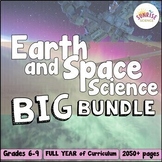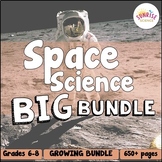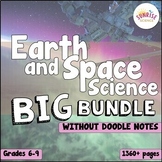Hubble Space Telescope Activity Webquest and Video Worksheet
- Zip
- Internet Activities
- Webquests
What educators are saying
Also included in
- Looking for fun, student-centered, and engaging activities to add into your Astronomy and Space unit? This Astronomy and Space Activities bundle contains engaging resources to add to your unit! These are the topics that are included in this bundle:- space exploration- planets of the solar system- suPrice $27.00Original Price $33.12Save $6.12
- This is a bundle of all of my resources for teaching Earth and Space Science at the middle school level! These resources include a mix of Cornell Doodle Notes, lab activities, inquiry activities, digital lessons and units, projects, and pixel art digital content review activities.✨ Please note thatPrice $327.00Original Price $450.24Save $123.24
- This is a bundle of all of my resources for teaching Space Science at the middle school level! These resources include a mix of Cornell Doodle Notes, lab activities, inquiry activities, digital units with assessments, projects, and pixel art digital content review activities.Receive 25% off this BIGPrice $97.00Original Price $129.34Save $32.34
- This is a bundle of all of my resources for teaching Earth and Space Science at the middle school level, EXCLUDING the Cornell Doodle Notes. The resources in this bundle include a mix of digital lessons and units, lab activities, inquiry activities, projects, review activities, and assessments.✨ ThiPrice $259.00Original Price $369.00Save $110.00
Description
This Hubble Space Telescope Activity includes a scavenger hunt webquest and a video worksheet that goes along with NOVA's Invisible Universe Revealed documentary. This 2-part activity gives students an appreciation for the amazing story, design, and contributions of the Hubble Space Telescope. The technological planning and troubleshooting that went into the success of this space telescope is remarkable. Students get to learn about this in the documentary.
The first activity is a webquest or “scavenger hunt” for which students view and answer questions about some of the beautiful photos taken by Hubble on the SpaceTelescope.org website. The link to make a copy as a Google Drive version is included in this product. You can post this assignment on your Google Classroom so that students can type directly into the document, but this could be easily adapted to a paper version! However, it is best if students can see the pictures in color, so displaying the color images on a document camera or giving groups of students copies of the colored version to accompany their individual black-and-white versions would work as well. Eleven of the Hubble’s mesmerizing photographs are included in the webquest. Students will navigate through the to find each of the eleven photographs. They will record the name of the nebula/star cluster/galaxy, and then read the information provided as a caption on the photo in order to answer the specific questions asked on the worksheet.
I chose the most riveting of Hubble’s shots, but I find that this activity innately differentiates the material because students who are interested and excited by the photos will click on and learn about many more than the required photos. There is also a last page on which students will choose four more of their favorite photographs to document and write questions about.
The second activity is to show the NOVA documentary called Invisible Universe Revealed and have students complete either the Anticipation Guide (good for younger or lower-level students), or the full video worksheet. I have found that either activity keeps them actively listening. The second activity provides a set of notes on the facts presented in the video.
This documentary is available for free at http://bit.ly/3k743cw and also at https://www.youtube.com/watch?v=2h-x4v1_0_w. It is an excellent documentary about the designing and launching of the Hubble Space Telescope. The video discusses the progressive contributions that Edwin Hubble made to the field of astronomy and the space program, interviews the scientists, engineers, and astronauts who were most influential to the Hubble mission, and explains the science behind how the telescope was designed, how it gathers data, and how a major mistake was remedied. After completing the webquest and watching this video, students come away with a great sense of the influence that this single telescope has had on the human space endeavor.
There is an editable (Word and Powerpoint) version included. I also included an anticipation guide for the video and some follow-up ideas for extending this into a mini-unit on Hubble. This product would work great as a sub plan if your students have access to computers!
You may also be interested my other Space and Astronomy Resources!
Thanks for looking!
Sunrise Science









